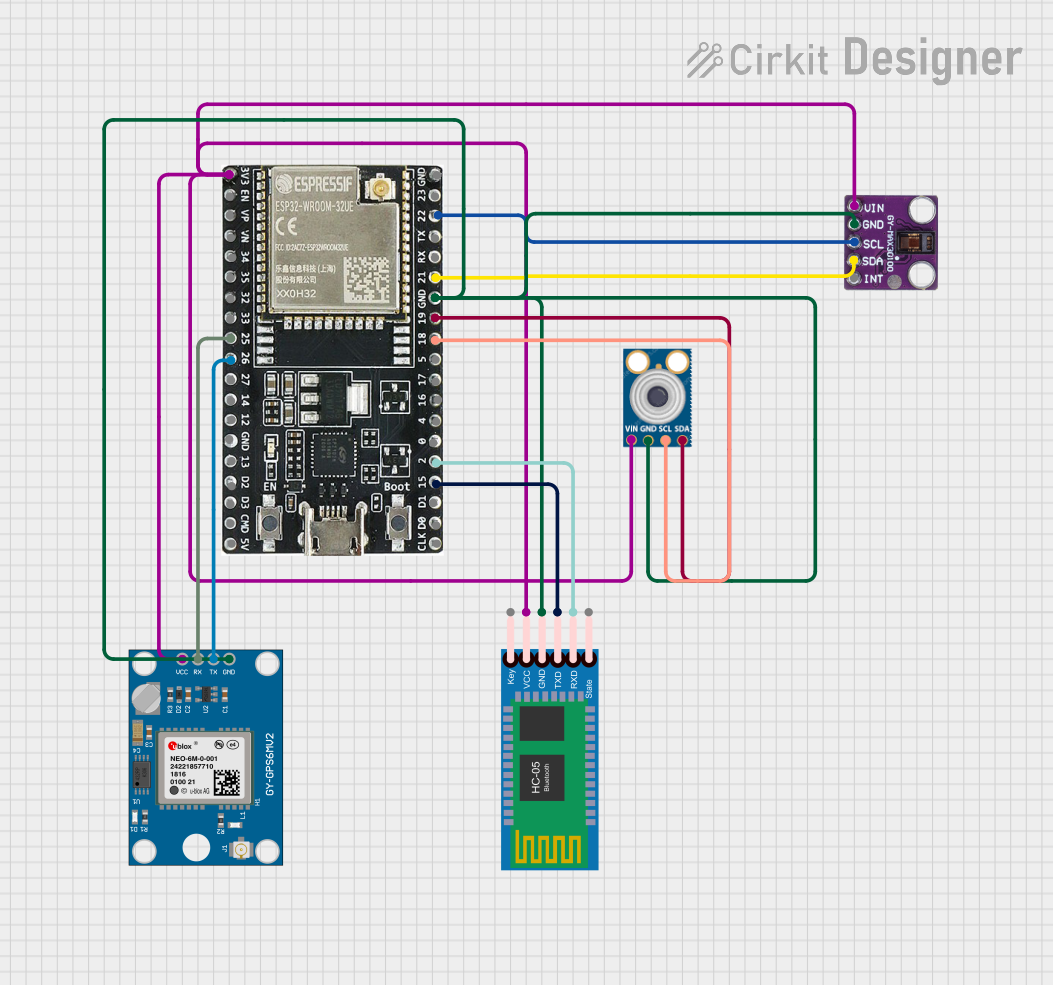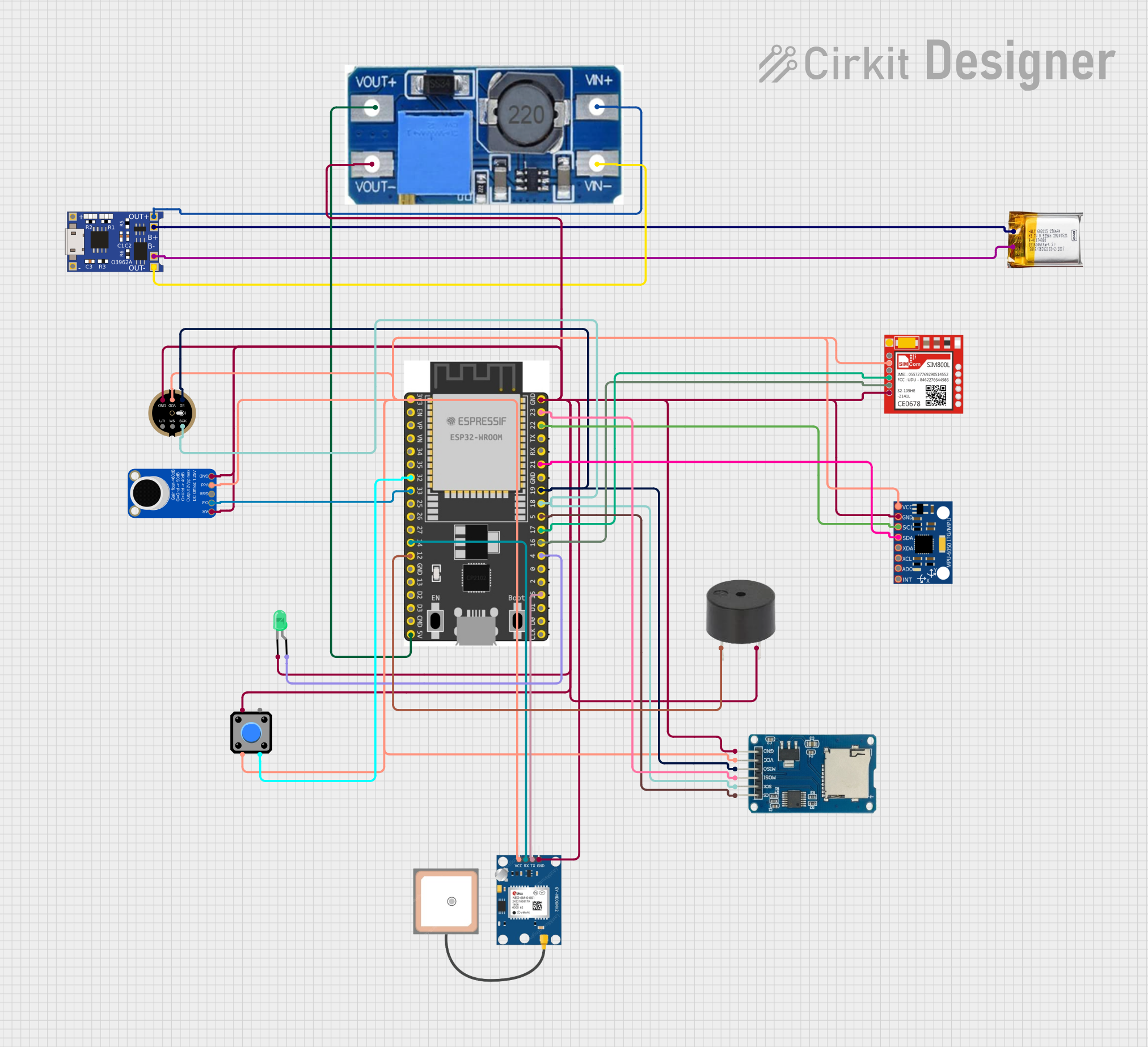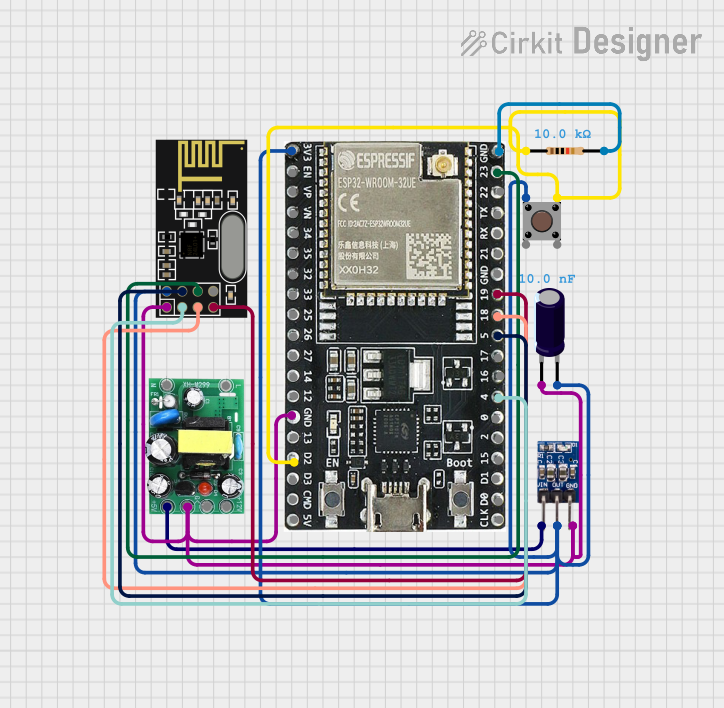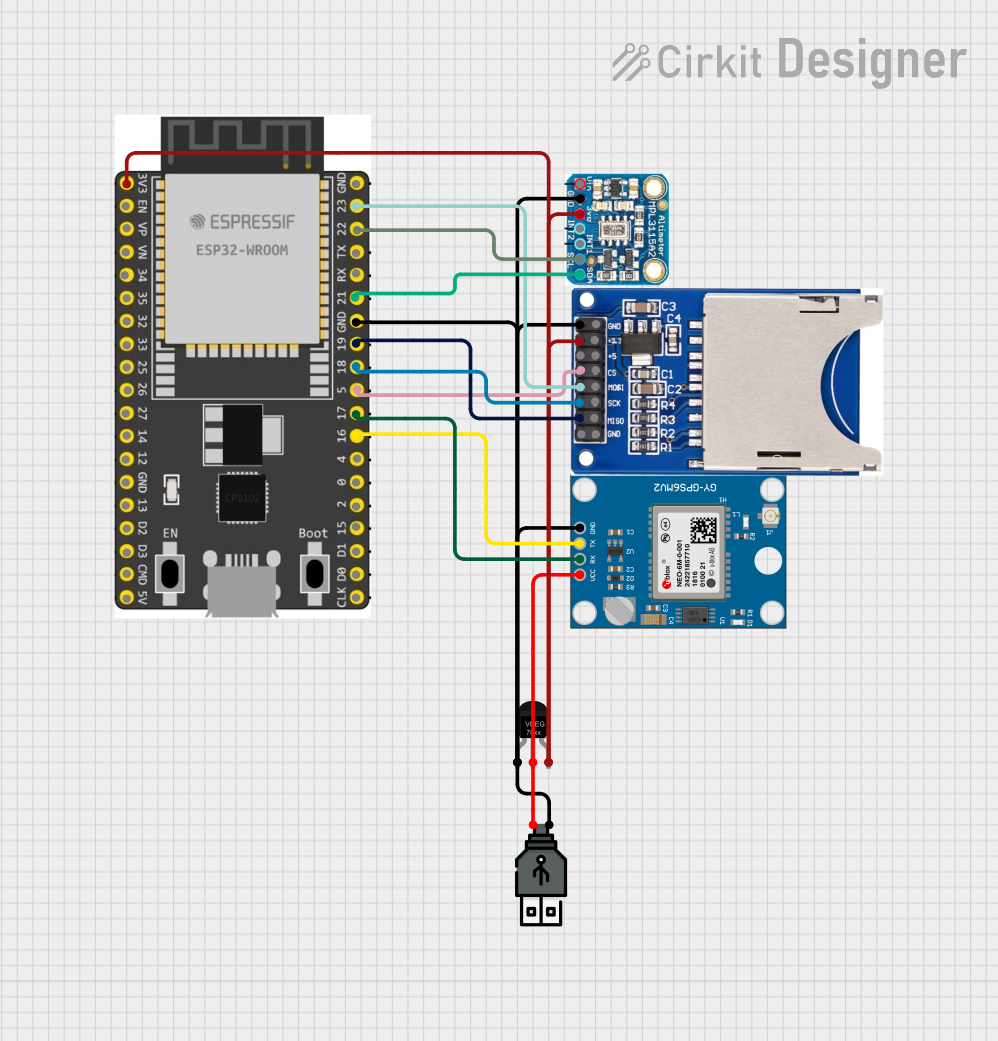
How to Use ESP-WROOM-32-cpu-front: Examples, Pinouts, and Specs

 Design with ESP-WROOM-32-cpu-front in Cirkit Designer
Design with ESP-WROOM-32-cpu-front in Cirkit DesignerIntroduction
The ESP-WROOM-32 is a powerful Wi-Fi and Bluetooth module designed for IoT (Internet of Things) applications. It integrates a dual-core processor, offering high performance and versatility for a wide range of projects. This module is known for its low power consumption, extensive GPIO pin availability, and support for multiple communication protocols, making it a popular choice for developers and hobbyists alike.
Explore Projects Built with ESP-WROOM-32-cpu-front

 Open Project in Cirkit Designer
Open Project in Cirkit Designer
 Open Project in Cirkit Designer
Open Project in Cirkit Designer
 Open Project in Cirkit Designer
Open Project in Cirkit Designer
 Open Project in Cirkit Designer
Open Project in Cirkit DesignerExplore Projects Built with ESP-WROOM-32-cpu-front

 Open Project in Cirkit Designer
Open Project in Cirkit Designer
 Open Project in Cirkit Designer
Open Project in Cirkit Designer
 Open Project in Cirkit Designer
Open Project in Cirkit Designer
 Open Project in Cirkit Designer
Open Project in Cirkit DesignerCommon Applications and Use Cases
- Smart home devices (e.g., smart lights, thermostats)
- Wearable technology
- Industrial automation
- Wireless sensor networks
- IoT gateways and hubs
- Prototyping and development of connected devices
Technical Specifications
Key Technical Details
- Processor: Dual-core Xtensa® 32-bit LX6 CPU
- Clock Speed: Up to 240 MHz
- Flash Memory: 4 MB (default, can vary by model)
- RAM: 520 KB SRAM
- Wi-Fi: 802.11 b/g/n (2.4 GHz)
- Bluetooth: v4.2 BR/EDR and BLE
- Operating Voltage: 3.0V to 3.6V
- Power Consumption: Ultra-low power (varies by mode)
- GPIO Pins: 34 (multipurpose, including ADC, DAC, PWM, I2C, SPI, UART)
- Operating Temperature: -40°C to +85°C
- Dimensions: 18 mm x 25.5 mm x 3.1 mm
Pin Configuration and Descriptions
The ESP-WROOM-32 module has 38 pins, but not all are available for general use. Below is a table of key pins and their functions:
| Pin Number | Pin Name | Function |
|---|---|---|
| 1 | EN | Enable pin. Active high. Used to reset the module. |
| 2 | IO0 | GPIO0. Can be used for general I/O or boot mode selection. |
| 3 | IO2 | GPIO2. General-purpose I/O. |
| 4 | IO4 | GPIO4. General-purpose I/O. |
| 5 | IO5 | GPIO5. General-purpose I/O. |
| 6 | IO12 | GPIO12. Can be used as ADC2 or general-purpose I/O. |
| 7 | IO13 | GPIO13. Can be used as ADC2 or general-purpose I/O. |
| 8 | IO14 | GPIO14. Can be used as ADC2 or general-purpose I/O. |
| 9 | IO15 | GPIO15. Can be used as ADC2 or general-purpose I/O. |
| 10 | IO16 | GPIO16. General-purpose I/O. |
| 11 | IO17 | GPIO17. General-purpose I/O. |
| 12 | IO18 | GPIO18. SPI clock or general-purpose I/O. |
| 13 | IO19 | GPIO19. SPI MISO or general-purpose I/O. |
| 14 | IO21 | GPIO21. I2C SDA or general-purpose I/O. |
| 15 | IO22 | GPIO22. I2C SCL or general-purpose I/O. |
| 16 | IO23 | GPIO23. SPI MOSI or general-purpose I/O. |
| 17 | GND | Ground. Connect to the ground of the power supply. |
| 18 | 3V3 | 3.3V power input. |
Note: Some GPIO pins have specific restrictions or are used during boot. Refer to the ESP32 datasheet for detailed pin behavior.
Usage Instructions
How to Use the ESP-WROOM-32 in a Circuit
- Power Supply: Provide a stable 3.3V power supply to the
3V3pin. Ensure the ground (GND) is connected to the circuit's ground. - Boot Mode: To upload code, connect GPIO0 to ground during reset. For normal operation, leave GPIO0 unconnected or pull it high.
- Programming: Use a USB-to-serial adapter (e.g., FTDI or CP2102) to connect the module to your computer. Connect the following:
- TX of the adapter to RX of the ESP-WROOM-32
- RX of the adapter to TX of the ESP-WROOM-32
- GND of the adapter to GND of the ESP-WROOM-32
- Communication Protocols: Use the appropriate pins for I2C, SPI, UART, or PWM as needed for your application.
Important Considerations and Best Practices
- Voltage Levels: The ESP-WROOM-32 operates at 3.3V. Do not expose GPIO pins to 5V signals.
- Antenna Placement: Ensure the onboard antenna has sufficient clearance from metal objects to avoid signal interference.
- Heat Management: If operating at high loads, consider adding a heatsink or ensuring proper ventilation.
- Firmware Updates: Keep the firmware updated to the latest version for improved performance and security.
Example: Connecting to an Arduino UNO
The ESP-WROOM-32 can be used with an Arduino UNO for Wi-Fi or Bluetooth functionality. Below is an example of connecting the ESP-WROOM-32 to an Arduino UNO and uploading a basic Wi-Fi scan sketch.
Wiring Diagram
| Arduino UNO Pin | ESP-WROOM-32 Pin |
|---|---|
| 3.3V | 3V3 |
| GND | GND |
| TX | RX |
| RX | TX |
Code Example
#include <WiFi.h> // Include the Wi-Fi library for ESP32
void setup() {
Serial.begin(115200); // Initialize serial communication
WiFi.mode(WIFI_STA); // Set Wi-Fi mode to station
WiFi.disconnect(); // Disconnect from any previous connections
delay(100);
Serial.println("Starting Wi-Fi scan...");
int n = WiFi.scanNetworks(); // Scan for available networks
Serial.println("Scan complete.");
if (n == 0) {
Serial.println("No networks found.");
} else {
Serial.println("Networks found:");
for (int i = 0; i < n; ++i) {
// Print SSID and signal strength of each network
Serial.print(i + 1);
Serial.print(": ");
Serial.print(WiFi.SSID(i));
Serial.print(" (");
Serial.print(WiFi.RSSI(i));
Serial.println(" dBm)");
}
}
}
void loop() {
// Nothing to do here
}
Note: Ensure the ESP-WROOM-32 is in programming mode when uploading the sketch.
Troubleshooting and FAQs
Common Issues
- Module Not Responding:
- Ensure the power supply is stable and provides sufficient current (at least 500 mA).
- Check the connections, especially TX and RX lines.
- Wi-Fi Not Connecting:
- Verify the SSID and password.
- Ensure the router is operating on the 2.4 GHz band (ESP-WROOM-32 does not support 5 GHz).
- Upload Fails:
- Ensure GPIO0 is grounded during reset for programming mode.
- Check the USB-to-serial adapter drivers on your computer.
Solutions and Tips for Troubleshooting
- Use a multimeter to verify voltage levels on the
3V3andGNDpins. - If the module overheats, reduce the clock speed or optimize your code to reduce processing load.
- For debugging, use the
Serial.print()function to output messages to the serial monitor.
By following this documentation, you can effectively integrate the ESP-WROOM-32 into your projects and troubleshoot common issues.